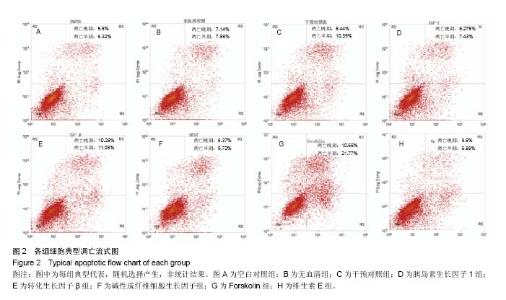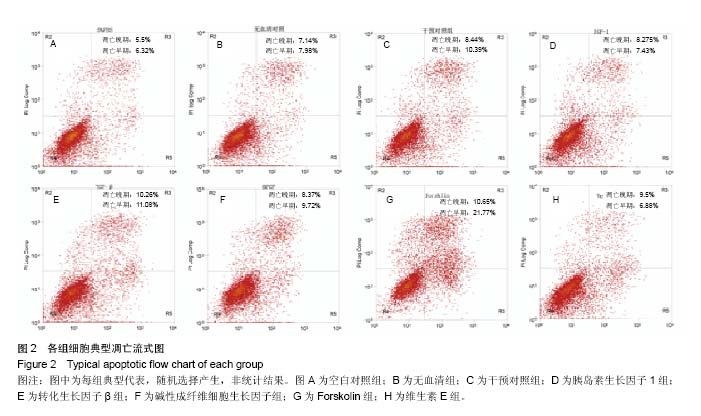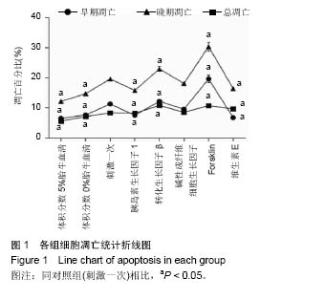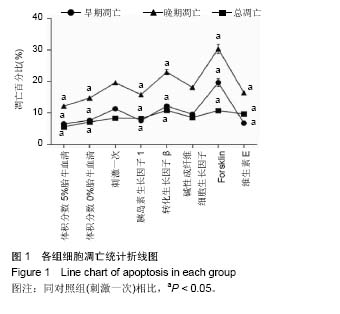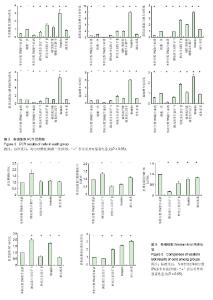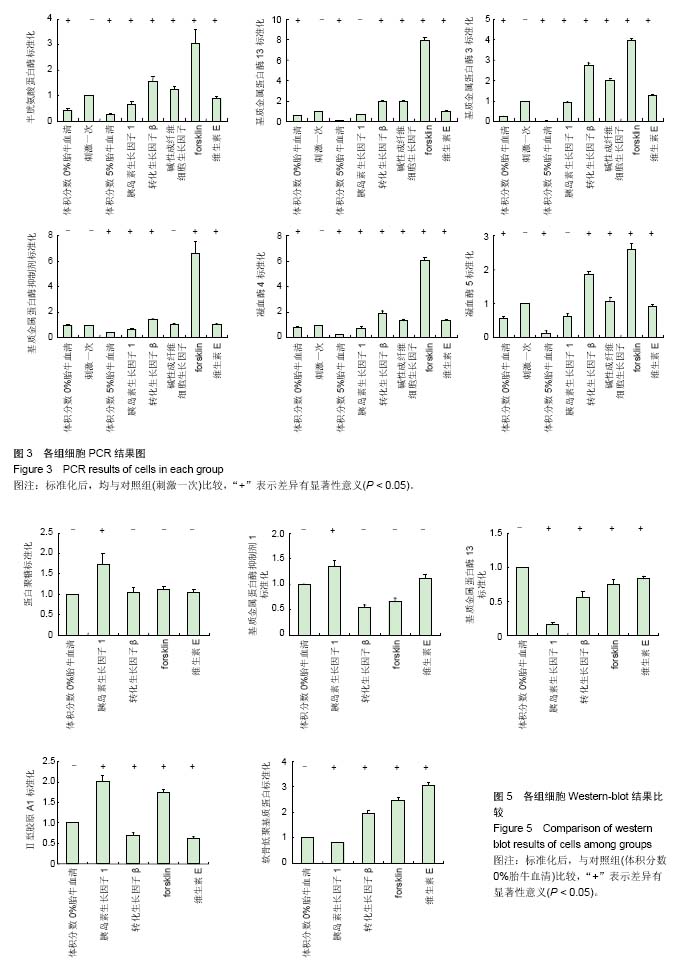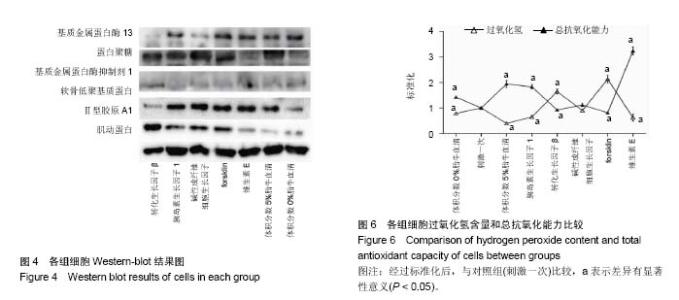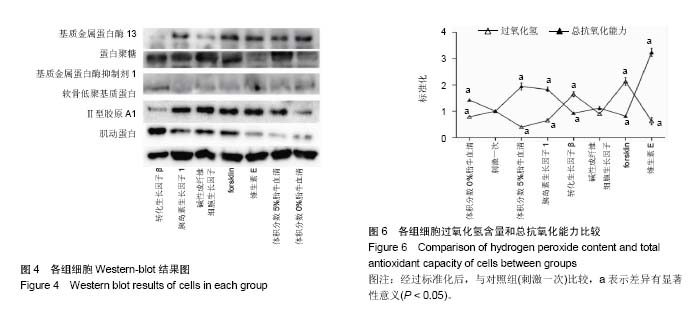Chinese Journal of Tissue Engineering Research ›› 2017, Vol. 21 ›› Issue (4): 520-526.doi: 10.3969/j.issn.2095-4344.2017.04.005
Previous Articles Next Articles
Effects of different growth factors on the antioxidant capacity of endplate chondrocytes
Huang Xiao-dong1, Deng Guo-ying2, Wang Wei-heng1, Xu Li-zhang1, Ma Jun1, Ye Xiao-jian1
- 1Department of Spine Surgery, Shanghai Changzheng Hospital of the Second Military Medical University, Shanghai 200433, China; 2Shanghai General Hospital, Shanghai Jiao Tong University, Shanghai 200000, China
-
Received:2016-11-23Online:2017-02-08Published:2017-03-13 -
Contact:Corresponding author: Ye Xiao-jian, M.D., Chief physician, Department of Spine Surgery, Shanghai Changzheng of the Second Military Medical University, Shanghai 200433, China -
About author:Huang Xiao-dong, Studying for doctorate, Department of Spine Surgery, Shanghai Changzheng Hospital of the Second Military Medical University, Shanghai 200433, China -
Supported by:the National Natural Science Foundation of China, No. 81472071; the National High-Tech Research & Development Program of China (863 Program), No. 2013AA032203
CLC Number:
Cite this article
Huang Xiao-dong1, Deng Guo-ying2, Wang Wei-heng1, Xu Li-zhang1, Ma Jun1, Ye Xiao-jian1. Effects of different growth factors on the antioxidant capacity of endplate chondrocytes[J]. Chinese Journal of Tissue Engineering Research, 2017, 21(4): 520-526.
share this article
| [1] Hu H, Yang B, Li Y, et al. Blocking of the P2X7 receptor inhibits the activation of the MMP-13 and NF-kappaB pathways in the cartilage tissue of rats with osteoarthritis. Int J Mol Med. 2016.[2] Lima MA, Dos Santos L, Turri JA, et al. Prognostic Value of ADAMTS Proteases and Their Substrates in Epithelial Ovarian Cancer. Pathobiology. 2016;83(6):316-326.[3] Gavella M, Lipovac V. Protective effects of exogenous gangliosides on ROS-induced changes in human spermatozoa. Asian J Androl. 2013;15(3):375-381.[4] Sunde RA, Thompson KM, Fritsche KL, et al. Minimum Selenium Requirements Increase When Repleting Second-Generation Selenium-Deficient Rats but Are Not Further Altered by Vitamin E Deficiency. Biol Trace Elem Res. 2016.[5] Goldar S, Baradaran B, Shekari Khaniani M, et al. Extracts of Scrophularia frigida Boiss display potent antitumor effects in human breast cancer cells by inducing apoptosis and inhibition of expression of the human epidermal growth factor receptor 2. Cell Mol Biol (Noisy-le-grand). 2016;62(9): 83-89.[6] Schmolz L, Birringer M, Lorkowski S, et al. Complexity of vitamin E metabolism. World J Biol Chem. 2016;7(1):14-43.[7] Sharma AN, da Costa e Silva BF, Soares JC, et al. Role of trophic factors GDNF, IGF-1 and VEGF in major depressive disorder: A comprehensive review of human studies. J Affect Disord. 2016;197:9-20.[8] Bauge C, Girard N, Lhuissier E, et al. Regulation and Role of TGFbeta Signaling Pathway in Aging and Osteoarthritis Joints. Aging Dis. 2014;5(6):394-405.[9] Iwona BS. Growth factors in pathogenesis of retinal neurodegeneration in diabetes mellitus Affiliation. Curr Neuropharmacol. 2016.[10] Baltanas A, Miguel-Carrasco J, San Jose G, et al. A synthetic peptide from transforming growth factor-beta(1) type III receptor inhibits NADPH oxidase and prevents oxidative stress in the kidney of spontaneously hypertensive rats. Antioxid Redox Signal. 2013;19(14):1607-1618.[11] Liegl R, Lofqvist C, Hellstrom A, et al. IGF-1 in retinopathy of prematurity, a CNS neurovascular disease. Early Hum Dev. 2016.[12] Fernandez-Sola J, Planavila Porta A. New Treatment Strategies for Alcohol-Induced Heart Damage. Int J Mol Sci. 2016;17(10). pii: E1651.[13] Ripamonti U, Duarte R, Parak R, et al. Redundancy and Molecular Evolution: The Rapid Induction of Bone Formation by the Mammalian Transforming Growth Factor-beta3 Isoform. Front Physiol. 2016;7:396.[14] Cruz JS, Machado FS, Ropert C, et al. Molecular mechanisms of cardiac electromechanical remodeling during Chagas disease: Role of TNF and TGF-beta. Trends Cardiovasc Med. 2016.[15] Grinberg YY, Dibbern ME, Levasseur VA, et al. Insulin-like growth factor-1 abrogates microglial oxidative stress and TNF-alpha responses to spreading depression. J Neurochem. 2013;126(5):662-672.[16] van der Kraan PM. Age-related alterations in TGF beta signaling as a causal factor of cartilage degeneration in osteoarthritis. Biomed Mater Eng. 2014;24(1 Suppl):75-80.[17] Sipila KH, Ranga V, Rappu P, et al. Extracellular citrullination inhibits the function of matrix associated TGF-beta. Matrix Biol. 2016;55:77-89.[18] Li Y, Wang Y, Chubinskaya S, et al. Effects of insulin-like growth factor-1 and dexamethasone on cytokine-challenged cartilage: relevance to post-traumatic osteoarthritis. Osteoarthritis Cartilage. 2015;23(2):266-274.[19] Kumar P, Kumar A, Srivastava MK, et al. Association of Transforming Growth Factor Beta-1-509C/T Gene Polymorphism with Ischemic Stroke: A Meta Analysis. Basic Clin Neurosci. 2016;7(2):91-96.[20] Nithiananthan S, Crawford A, Cooper Knock J, et al. Physiological Fluid Flow Moderates Fibroblast Responses to TGF-beta1. J Cell Biochem. 2016.[21] Hagopian MM, Brekken RA. Stromal TGFbetaR2 signaling: a gateway to progression for pancreatic cancer. Mol Cell Oncol. 2015;2(3):e975606.[22] Kocer G, Naziroglu M, Celik O, et al. Basic fibroblast growth factor attenuates bisphosphonate-induced oxidative injury but decreases zinc and copper levels in oral epithelium of rat. Biol Trace Elem Res. 2013;153(1-3):251-256.[23] Li X, Su G, Wang J, et al. Exogenous bFGF promotes articular cartilage repair via up-regulation of multiple growth factors. Osteoarthritis Cartilage. 2013;21(10):1567-1575.[24] Niderla-Bielinska J, Ciszek B, Jankowska-Steifer E, et al. Mouse Proepicardium Exhibits a Sprouting Response to Exogenous Proangiogenic Growth Factors in vitro. J Vasc Res. 2016;53(1-2):83-93.[25] Groeger G, Doonan F, Cotter T, et al. Reactive oxygen species regulate prosurvival ERK1/2 signaling and bFGF expression in gliosis within the retina. Invest Ophthalmol Vis Sci. 2012;53(10):6645-54.[26] Hirano T, Mori Y. Anti-atherogenic and anti-inflammatory properties of glucagon-like peptide-1, glucose-dependent insulinotropic polypepide, and dipeptidyl peptidase-4 inhibitors in experimental animals. J Diabetes Investig. 2016;7 Suppl 1:80-86.[27] Mohammed KP, Aarey A, Tamkeen S, et al. Forskolin: genotoxicity assessment in Allium cepa. Mutat Res Genet Toxicol Environ Mutagen. 2015;777:29-32.[28] Brohlin M, Kingham PJ, Novikova LN, et al. Aging effect on neurotrophic activity of human mesenchymal stem cells. PLoS One. 2012;7(9):e45052.[29] Majeed M, Nagabhushanam K, Natarajan S, et al. Efficacy and safety of 1% forskolin eye drops in open angle glaucoma - An open label study. Saudi J Ophthalmol. 2015; 29(3):197-200.[30] Cavallaro G, Bijker E, Strackx E, et al. Age-related changes and effects of mild hypothermia on carotid artery reactivity in newborn rats. CNS Neurol Disord Drug Targets. 2015; 14(1):91-101.[31] Hu LM, Kemp SF, Elders MJ, et al. Metabolic effects of forskolin in chick chondrocytes. Biochim Biophys Acta. 1989;1013(3):294-299.[32] Gusan S, Anand-Srivastava MB. cAMP attenuates the enhanced expression of Gi proteins and hyperproliferation of vascular smooth muscle cells from SHR: role of ROS and ROS-mediated signaling. Am J Physiol Cell Physiol. 2013; 304(12):C1198-1209.[33] Kamata H, Tanaka C, Yagisawa H, et al. Nerve growth factor and forskolin prevent H2O2-induced apoptosis in PC12 cells by glutathione independent mechanism. Neurosci Lett. 1996;212(3):179-182.[34] Finno CJ, Bordbari MH, Valberg SJ, et al. Transcriptome profiling of equine vitamin E deficient neuroaxonal dystrophy identifies upregulation of liver X receptor target genes. Free Radic Biol Med. 2016.[35] Boubakri H, Gargouri M, Mliki A, et al. Vitamins for enhancing plant resistance. Planta. 2016;244(3):529-543.[36] Oh YI, Kim JH, and Kang CW. Protective effect of short-term treatment with parathyroid hormone 1-34 on oxidative stress is involved in insulin-like growth factor-I and nuclear factor erythroid 2-related factor 2 in rat bone marrow derived mesenchymal stem cells. Regul Pept. 2014; 189:1-10. |
| [1] | Zhang Haobo, Zhao Yunan, Yang Xuejun. Role and therapeutic implications of pyroptosis in intervertebral disc degeneration [J]. Chinese Journal of Tissue Engineering Research, 2022, 26(9): 1445-1451. |
| [2] | Yao Xiaoling, Peng Jiancheng, Xu Yuerong, Yang Zhidong, Zhang Shuncong. Variable-angle zero-notch anterior interbody fusion system in the treatment of cervical spondylotic myelopathy: 30-month follow-up [J]. Chinese Journal of Tissue Engineering Research, 2022, 26(9): 1377-1382. |
| [3] | Zhang Jinglin, Leng Min, Zhu Boheng, Wang Hong. Mechanism and application of stem cell-derived exosomes in promoting diabetic wound healing [J]. Chinese Journal of Tissue Engineering Research, 2022, 26(7): 1113-1118. |
| [4] | An Weizheng, He Xiao, Ren Shuai, Liu Jianyu. Potential of muscle-derived stem cells in peripheral nerve regeneration [J]. Chinese Journal of Tissue Engineering Research, 2022, 26(7): 1130-1136. |
| [5] | Xu Jing, Yan Yongmin, Cai Mengjie . miR-373 inhibits hepatic stellate cell activation by downregulating transforming growth factor beta type II receptor [J]. Chinese Journal of Tissue Engineering Research, 2022, 26(5): 756-761. |
| [6] | Hou Wanxing, Li Hongwei, Zheng Xin, Zhu Xianren. Correlation between preoperative magnetic resonance imaging findings and bone cement leakage after percutaneous vertebral augmentation [J]. Chinese Journal of Tissue Engineering Research, 2022, 26(4): 504-509. |
| [7] | He Yunying, Li Lingjie, Zhang Shuqi, Li Yuzhou, Yang Sheng, Ji Ping. Method of constructing cell spheroids based on agarose and polyacrylic molds [J]. Chinese Journal of Tissue Engineering Research, 2022, 26(4): 553-559. |
| [8] | He Guanyu, Xu Baoshan, Du Lilong, Zhang Tongxing, Huo Zhenxin, Shen Li. Biomimetic orientated microchannel annulus fibrosus scaffold constructed by silk fibroin [J]. Chinese Journal of Tissue Engineering Research, 2022, 26(4): 560-566. |
| [9] | Chen Xiaoxu, Luo Yaxin, Bi Haoran, Yang Kun. Preparation and application of acellular scaffold in tissue engineering and regenerative medicine [J]. Chinese Journal of Tissue Engineering Research, 2022, 26(4): 591-596. |
| [10] | Kang Kunlong, Wang Xintao. Research hotspot of biological scaffold materials promoting osteogenic differentiation of bone marrow mesenchymal stem cells [J]. Chinese Journal of Tissue Engineering Research, 2022, 26(4): 597-603. |
| [11] | Shen Jiahua, Fu Yong. Application of graphene-based nanomaterials in stem cells [J]. Chinese Journal of Tissue Engineering Research, 2022, 26(4): 604-609. |
| [12] | Zhang Tong, Cai Jinchi, Yuan Zhifa, Zhao Haiyan, Han Xingwen, Wang Wenji. Hyaluronic acid-based composite hydrogel in cartilage injury caused by osteoarthritis: application and mechanism [J]. Chinese Journal of Tissue Engineering Research, 2022, 26(4): 617-625. |
| [13] | Li Hui, Chen Lianglong. Application and characteristics of bone graft materials in the treatment of spinal tuberculosis [J]. Chinese Journal of Tissue Engineering Research, 2022, 26(4): 626-630. |
| [14] | Gao Cangjian, Yang Zhen, Liu Shuyun, Li Hao, Fu Liwei, Zhao Tianyuan, Chen Wei, Liao Zhiyao, Li Pinxue, Sui Xiang, Guo Quanyi. Electrospinning for rotator cuff repair [J]. Chinese Journal of Tissue Engineering Research, 2022, 26(4): 637-642. |
| [15] | Li Yanting, Chen Jian, Liu Menglan, Ren Manman, Zhong Weihong, Chen Changxing. Three-dimensional finite element analysis of Daogaijinbei manipulation on lumbar intervertebral disc biomechanics [J]. Chinese Journal of Tissue Engineering Research, 2022, 26(3): 340-343. |
| Viewed | ||||||
|
Full text |
|
|||||
|
Abstract |
|
|||||
